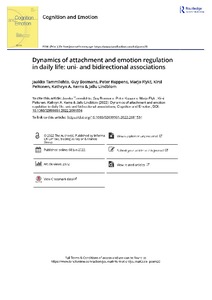Dynamics of attachment and emotion regulation in daily life: uni- and bidirectional associations
Tammilehto Jaakko; Bosmans Guy; Kuppens Peter; Flykt Marjo; Peltonen Kirsi; Kerns Kathryn A.; Lindblom Jallu
https://urn.fi/URN:NBN:fi-fe2022091258480
Tiivistelmä
Attachment theory proposes that the activation of the attachment system enacts emotion regulation (ER) to maintain security or cope with insecurity. However, the effects of ER on attachment states and their bidirectional influences remain poorly understood. In this ecological momentary assessment study, we examined the dynamics between attachment and ER. We hypothesised that attachment states and ER influence each other through time. Specifically, we hypothesised bidirectional short-term cycles between state attachment security and reappraisal, state attachment anxiety and rumination, and state attachment avoidance and suppression. We also tested how trait attachment is related to state attachment and ER. One hundred twenty-two participants (Mage = 26.4) completed the Experiences in Close Relationship–Revised and reported state attachment and ER seven times daily for seven days. The results were only partly consistent with our cycle hypotheses yet revealed a cycle between low state attachment security and rumination that was attenuated by reappraisal. Moreover, rumination and suppression predicted increased insecure states, and reappraisal predicted increased secure and insecure states. Finally, trait attachment showed associations with state attachment and ER. Our study suggests regulatory dynamics between attachment and ER and opens important questions about their functional relationship in maintaining attachment-related behavioural patterns and emotional well-being
Kokoelmat
- Rinnakkaistallenteet [27094]
